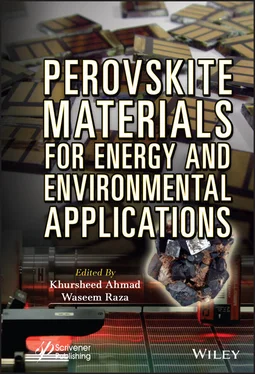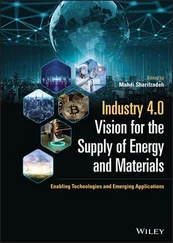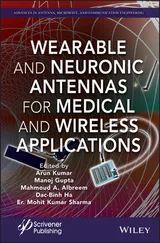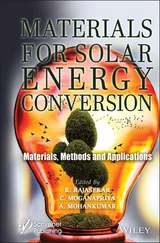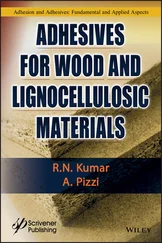Perovskite Materials for Energy and Environmental Applications
Здесь есть возможность читать онлайн «Perovskite Materials for Energy and Environmental Applications» — ознакомительный отрывок электронной книги совершенно бесплатно, а после прочтения отрывка купить полную версию. В некоторых случаях можно слушать аудио, скачать через торрент в формате fb2 и присутствует краткое содержание. Жанр: unrecognised, на английском языке. Описание произведения, (предисловие) а так же отзывы посетителей доступны на портале библиотеки ЛибКат.
- Название:Perovskite Materials for Energy and Environmental Applications
- Автор:
- Жанр:
- Год:неизвестен
- ISBN:нет данных
- Рейтинг книги:5 / 5. Голосов: 1
-
Избранное:Добавить в избранное
- Отзывы:
-
Ваша оценка:
- 100
- 1
- 2
- 3
- 4
- 5
Perovskite Materials for Energy and Environmental Applications: краткое содержание, описание и аннотация
Предлагаем к чтению аннотацию, описание, краткое содержание или предисловие (зависит от того, что написал сам автор книги «Perovskite Materials for Energy and Environmental Applications»). Если вы не нашли необходимую информацию о книге — напишите в комментариях, мы постараемся отыскать её.
The book provides a state-of-the-art summary and discussion about the recent progress in the development and engineering of perovskite solar cells materials along with the future directions it might take.
Audience
Perovskite Materials for Energy and Environmental Applications — читать онлайн ознакомительный отрывок
Ниже представлен текст книги, разбитый по страницам. Система сохранения места последней прочитанной страницы, позволяет с удобством читать онлайн бесплатно книгу «Perovskite Materials for Energy and Environmental Applications», без необходимости каждый раз заново искать на чём Вы остановились. Поставьте закладку, и сможете в любой момент перейти на страницу, на которой закончили чтение.
Интервал:
Закладка:
Every data related to GaAs, Si, CIGS, CdTe, nanocrystalline Si (nc-Si), amorphous Si (a-Si), copper zinc tin sulfide/selenide (CZTSSe), organic photovoltaics (OPVs), and DSSCs were provided by the solar cell efficiency tables of Green et al. [35].
CdTe solar cell was the most successful solar cell commercially till 2015 with 19.6% efficiency with losses of approximately 0.59eV. The basic losses of CdTe solar cells are high as compared with perovskites cells [35]. The recombination rate (nonradiative) in perovskite absorber material is lower than polycrystalline film semiconductor [32]. High output voltage is one of the important factors which is responsible for high power conversion efficiency. We know that perovskite is placed in a very good position compared with the other materials for making solar cells. Voltage at maximum power point (V mpp) is to be considered as the most relevant voltage for considering maximum efficiency [36]. Because of the manufacturing defects, there is high series resistance, which greatly affects the V mpp. On optimization of solar cells the V mppwill improve significantly [1].
2.5.3 Low Recombinations
In the recombination process, the excited electrons in the conduction band deexcite in the valence band and occupy the hole. This process can also be termed as electron hole pair recombination. This process competes with the process of separation of the excitation to electrons and holes and their collection at the electrodes. Because of this, there is a decline in the efficiency and current of the solar cell [32].
Recombinations are of two types: radiative and nonradiative recombination. When an electron deexcites from conduction band to valence band it releases a photon to release energy called radiative recombination. Whereas in nonradiative recombination, when an electron deexcites the energy is released in the form of heat. It causes harm to the performance of the cell. The device gets heated up during nonradiative recombinations due to which efficiency gets decreased.
Diffusion length is defined as the average length a carrier moves between its generation/formation and its recombination. On the basis of diffusion length parameters, the semiconductor material can be assessed for solar cell applications. Semiconductor materials have a shorter diffusion length and higher recombinations because they are heavily doped. If the diffusion length is higher, then the longer will be the lifetime of recombinations, the better the collection of carriers at the electrode. CH 3NH 3PBI 3−xCl xhas a diffusion length of more than 1 micron. This diffusion length is almost three times the thickness of the film in solar cells [37].
For constructing planar heterojunction solar devices this characteristic is very important. As the diffusion length of perovskite(CH 3NH 3PBI 3) is only a hundred nanometer, so for transportation of charges to terminals, a nanoparticle system of a mesoporous TiO 2is required [38].
2.5.4 Tunable Bandgap
For designing the solar cell, it is necessary that the light absorber is absorbing the maximum amount of the sunlight. To achieve this, we have to tune the band gap of the absorber. So here perovskite has been greatly advantageous as a light absorber because its bandgap is tunable/controllable. The perovskite has a structure of ABX 3. So the bandgap of the perovskite material (absorber) can easily be regulated by altering the organic cation (A) or the metal atom (B) or the halide (X).
2.5.4.1 Organic Cation (A)
In perovskite, structure changes in A do not remarkably alter the structures, but it can alter it to some extent [38]. The structure of the band of CH 3NH 3PBI 3is near to its optimum value for solar applications, so the small change/alteration will help tune the band gap to its optimum value. NH 2-CH=NH 2 +(A) is replaced by CH 3NH 3 +in CH 3NH 3PbI 3to narrow the band gap. The band gap of perovskite formed after replacing A (NH 2-CH=NH 2PbI 3) is 1.4 eV [39].
Table 2.2 Band gap of different ABX 3materials [32].
| A substitution | M substitution | X substitution | |||
| Material | Band gap (eV) | Material | Band gap (eV) | Material | Band gap (eV) |
| EAPbI 3 | 2.2 | MaPbI 3 | 1.5 | MAPbI 3 | 1.5 |
| MAPbI 3 | 1.5 | MASn 0.3Pb 0.7I 3 | 1.31 | MAPbI 2Br | 1.8 |
| FAPbI 3 | 1.4 | MASn 0.5Pb 0.5I 3 | 1.28 | MAPbBr 3 | 2.20 |
| CsPbI 3 | 1.67 | MASn 0.9Pb 0.1I 3 | 1.18 | MAPbCl 3 | 3.11 |
| MASnI 3 | 1.10 |
The bandgap of CsPbI 3is 1.67 eV [40]. The trend that is observed here is increasing the size of “A| cation, i.e., from Cs +to CH 3NH +3and NH 2-CH=NH +2, the value of the bandgap steadily declines [32] as shown in Table 2.2. However, on further increasing the size of “A” to CH 3CH 2NH 2(EA), the perovskite [CH 3CH 2NH 3] +PbI 3structure turns into orthorhombic symmetry with a bandgap of 2.2 eV [38].
2.5.4.2 Metal Cation (M)
Lead (Pb) was majorly used as a metal cation. European Union has restricted the use of Pb as it is toxic to the environment (Restriction of the use of certain hazardous substances (RoHS), Directive 2011/65/EU.). These reasons have led to synthesize leadless perovskite for light absorbing. As an alternative of Pb, we can use tin because tin and Pb are in the same group, so obviously tin would be the first choice. After Sn and Pb ratio was optimized in CH 3NH 3Sn 1-xPb xI 3, it was observed that bandgap was tunable in the range of 1.17 to 1.55 eV. Because of this, it was found that the absorption capacity of light could be increased from visible region to the near-infrared region (1060 nm) [41].
The problem in CH 3NH 3Sn 1-xPb xI 3solar cells is that it is hard to make a consistent and thick absorber layer(film) on the area of the device, and because of these reasons, the efficiency drops down to 3% [41]. Tin-based solar perovskite cell (CH 3NH 3SnI 3) has 1.3eV bandgap. This perovskite can also absorb the light of the near-infrared region. The final power conversion efficiency of this device obtained was 5.37% [42]. Open circuit voltage of tin PSC always gets decreased because of downshifting of the conduction bandgap [38].
2.5.4.3 Halide Anion (X)
X position in perovskite can be replaced with elements chlorine, bromine, and iodine. There is a considerable proportion of change in bandgap when there is alternation in the element. Altering the position of X from chlorine to iodine the band gap value ranges from 3.11eV to 1.51eV. The smallest band gap of 1.51eV is obtained by tuning the position of X in CH 3NH 3PbX 3[38].
M and X elements should be changed simultaneously so that the appropriate bandgap can be obtained. The bandgap of CH 3NH 3SnI 3−xBr can be modulated from 1.30 to 2.15 eV by substitution of Pb with tin and partially substitution of I (iodine) with Br (bromine) x[42]. A linearity behavior is observed between bandgap and ratio of I/Br. Efficiency is achieved up to 5.23% when CH 3NH 3SnI 3is used as a light absorber in the solar cell [42]. On optimizing iodine and bromine ratio in CH 3NH 3SnIBr 2, a way better PSC can be produced.
2.5.5 Rapidly Increasing Efficiency
The power conversion efficiency of PSCs has raised from 3.8% [3] in 2009 to 22.10% in 2016. For cells having square area aperture greater than 1 cm 2has shown a verified efficiency of 19.6%. This efficiency is almost equal to efficiency obtained in 2017 by thin film CIGS and CdTe which is 21% [43]. Because of tunable band gaps in the solar cell, it can be optimized accordingly to the solar spectrum. Shockley–Queisser efficiency limit can be approached by this solar cell which is about 31% for a 1.55-eV band gap [44].
Читать дальшеИнтервал:
Закладка:
Похожие книги на «Perovskite Materials for Energy and Environmental Applications»
Представляем Вашему вниманию похожие книги на «Perovskite Materials for Energy and Environmental Applications» списком для выбора. Мы отобрали схожую по названию и смыслу литературу в надежде предоставить читателям больше вариантов отыскать новые, интересные, ещё непрочитанные произведения.
Обсуждение, отзывы о книге «Perovskite Materials for Energy and Environmental Applications» и просто собственные мнения читателей. Оставьте ваши комментарии, напишите, что Вы думаете о произведении, его смысле или главных героях. Укажите что конкретно понравилось, а что нет, и почему Вы так считаете.
